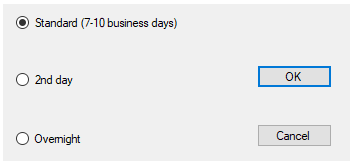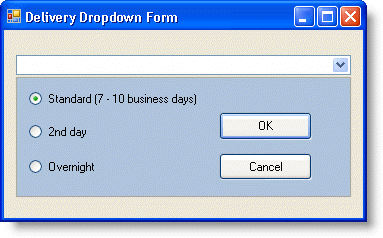- Input for WinForms Overview
- Key Features
- Design-Time Support
- Using the C1Input Controls
- Customizing C1Input's Appearance
-
Input for WinForms Task-Based Help
- Adding a Drop-Down Form
- Binding C1CheckBox
- Setting the Calendar Drop-down
- Customizing Appearance Using Visual Styles
- Customizing the C1DateEdit Control
- Displaying Clicked C1DropDown Buttons in a Text Box
- Navigating the C1DateEdit Control
- Displaying a Border Color for the C1Input Controls
- Showing a Message Box when the Border Color Changes
- Set IME Mode
- Move Focus
- Select Specific Calendar Type
- Spin Up/Spin Down Programmatically
- Change Up-Down Button Alignment
- Input for WinForms Samples
- Input for WinForms Tutorials
Customizing the Drop-Down Editor
The drop-down form below includes option buttons and button controls for the user to make a selection from the C1DropDownControl.
The drop-down form appearance properties have been edited so that the form appears as below:

Select the form class name (for this example, WindowsApplication1.DropDownForm1) in the DropDownFormClassName property of your C1DropDownControl. Notice that when you run the project and select the drop-down arrow, the drop-down form now appears.
Enable the button controls on the drop-down form:
Set the AcceptButton and CancelButton properties of your DropDownForm1 to button1 and button2, respectively.
Select the OK button and set its DialogResult property to OK. Similarly, select the Cancel button and set its DialogResult property to Cancel.
To make the drop-down form change the control text when it is closed after the user clicks an item, add the following event handler for the PostChanges event:
To write code in Visual Basic
Private Sub DropDownForm1_PostChanges(sender As Object, e As System.EventArgs) If (MyBase.DialogResult = DialogResult.OK) Then Dim control1 As Control For Each control1 In MyBase.Controls If (TypeOf control1 is RadioButton AndAlso CType(control1, RadioButton).Checked) Then MyBase.OwnerControl.Value = CType(control1, RadioButton).Text End If Next End If End SubTo write code in C#
private void DropDownForm1_PostChanges(object sender, System.EventArgs e) { if (DialogResult == DialogResult.OK) { foreach (Control control1 in Controls) { if (control1 as RadioButton != null && ((RadioButton)control1).Checked) { OwnerControl.Value = ((RadioButton)control1).Text; } } } }At design time, select DropDownForm1 to view its properties in the Properties window, and then select the Events button
 from the Properties toolbar.
from the Properties toolbar.Set the DropDownForm1.PostChanges event to DropDownForm1_PostChanges.
To make the OK button (button1) receive focus when the form opens, set the DropDownForm1.FocusControl property to button1.
To have a check in the Standard option button, in design time select radiobutton1 and set its Checked property to True.
This topic illustrates the following:
Your form should appear similar to the form below:



